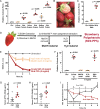The strawberry-derived permeation enhancer pelargonidin enables oral protein delivery
- PMID: 35943988
- PMCID: PMC9388159
- DOI: 10.1073/pnas.2207829119
The strawberry-derived permeation enhancer pelargonidin enables oral protein delivery
Abstract
Although patients generally prefer oral drug delivery to injections, low permeability of the gastrointestinal tract makes this method impossible for most biomacromolecules. One potential solution is codelivery of macromolecules, including therapeutic proteins or nucleic acids, with intestinal permeation enhancers; however, enhancer use has been limited clinically by modest efficacy and toxicity concerns surrounding long-term administration. Here, we hypothesized that plant-based foods, which are well tolerated by the gastrointestinal tract, may contain compounds that enable oral macromolecular absorption without causing adverse effects. Upon testing more than 100 fruits, vegetables, and herbs, we identified strawberry and its red pigment, pelargonidin, as potent, well-tolerated enhancers of intestinal permeability. In mice, an oral capsule formulation comprising pelargonidin and a 1 U/kg dose of insulin reduced blood glucose levels for over 4 h, with bioactivity exceeding 100% relative to subcutaneous injection. Effects were reversible within 2 h and associated with actin and tight junction rearrangement. Furthermore, daily dosing of mice with pelargonidin for 1 mo resulted in no detectable side effects, including weight loss, tissue damage, or inflammatory responses. These data suggest that pelargonidin is an exceptionally effective enhancer of oral protein uptake that may be safe for routine pharmaceutical use.
Keywords: oral drug delivery; permeation enhancers; protein therapeutics.
Conflict of interest statement
Competing interest statement: K.A.W. and N.G.L. are inventors on Patent Cooperation Treaty (PCT) application PCT/US2019/027885 and US patent application US 2021/0113519 A1, which cover aspects of the technology presented here.
Figures





References
-
- Zambanini A., Newson R. B., Maisey M., Feher M. D., Injection related anxiety in insulin-treated diabetes. Diabetes Res. Clin. Pract. 46, 239–246 (1999). - PubMed
-
- Roebuck M. C., Liberman J. N., Gemmill-Toyama M., Brennan T. A., Medication adherence leads to lower health care use and costs despite increased drug spending. Health Aff. (Millwood) 30, 91–99 (2011). - PubMed
-
- Moroz E., Matoori S., Leroux J. C., Oral delivery of macromolecular drugs: Where we are after almost 100 years of attempts. Adv. Drug Deliv. Rev. 101, 108–121 (2016). - PubMed
-
- Banna G. L., et al. , Anticancer oral therapy: Emerging related issues. Cancer Treat. Rev. 36, 595–605 (2010). - PubMed
Publication types
MeSH terms
Substances
Grants and funding
LinkOut - more resources
Full Text Sources
Other Literature Sources

